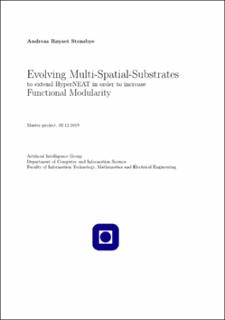| dc.description.abstract | Humanity have begun to actively use artificial intelligence to solve problems. However, many of these solutions are time consuming to develop and often fine-tuned to specific problems. With the world in constant change, we face many new challenges that require faster solutions. This work presents Evolved-Multi-Spatial Substrate HyperNEAT (EMSS-HyperNEAT) for evolving both topology and the developmental stage of an artificial neural network(ANN). It is based on the HyperNEAT algorithm, which traditionally expects a hand-crafted neuron geometry (substrate structure). Such hand-crafted substrate structures often require experience and deep understanding of the problem, and this may be hard to acquire for more complex problems. EMSS-HyperNEAT aims to automate this process, saving time and through evolution finds topologies that can reflect spatial aspects of the problem. The goal is that these discovered spatial properties can be utilized for more functional specialisation within the ANN, and thus achieve functional modularity.
We often observe functional modularity in
biological neural networks such as the brain, where different brain functions can be handled separately by modules consisting of neurons located physically close together. Despite nature often choosing modular neural networks, evolutionary algorithms have struggled with creating effective modular solutions for artificial neural network. This work investigates the effects of allowing evolution to search for both the substrate structure and the indirect encoding for the ANN connectivity, and explore the effect this has for functional modularity. | |
